Several species of ducks live in Washington due to its diverse landscape. These waterfowl find an ideal habitat in this state, with over 8,000 lakes and ponds and numerous rivers and waterways. Ducks are also attracted to the state’s shores for their abundance of food and sheltered areas for nesting.
The state’s large population of ducks makes it a popular spot for birdwatchers, nature enthusiasts and duck hunters.
What Ducks Are in Washington?
There are 36 different ducks in the state of Washington.
Barrow’s Goldeneye
Bufflehead
Canvasback
Cinnamon Teal
Common Goldeneye
Falcated Duck
Gadwall
Garganey
Mallard
Northern Shoveler
Redhead
Ring-Necked Duck
Smew
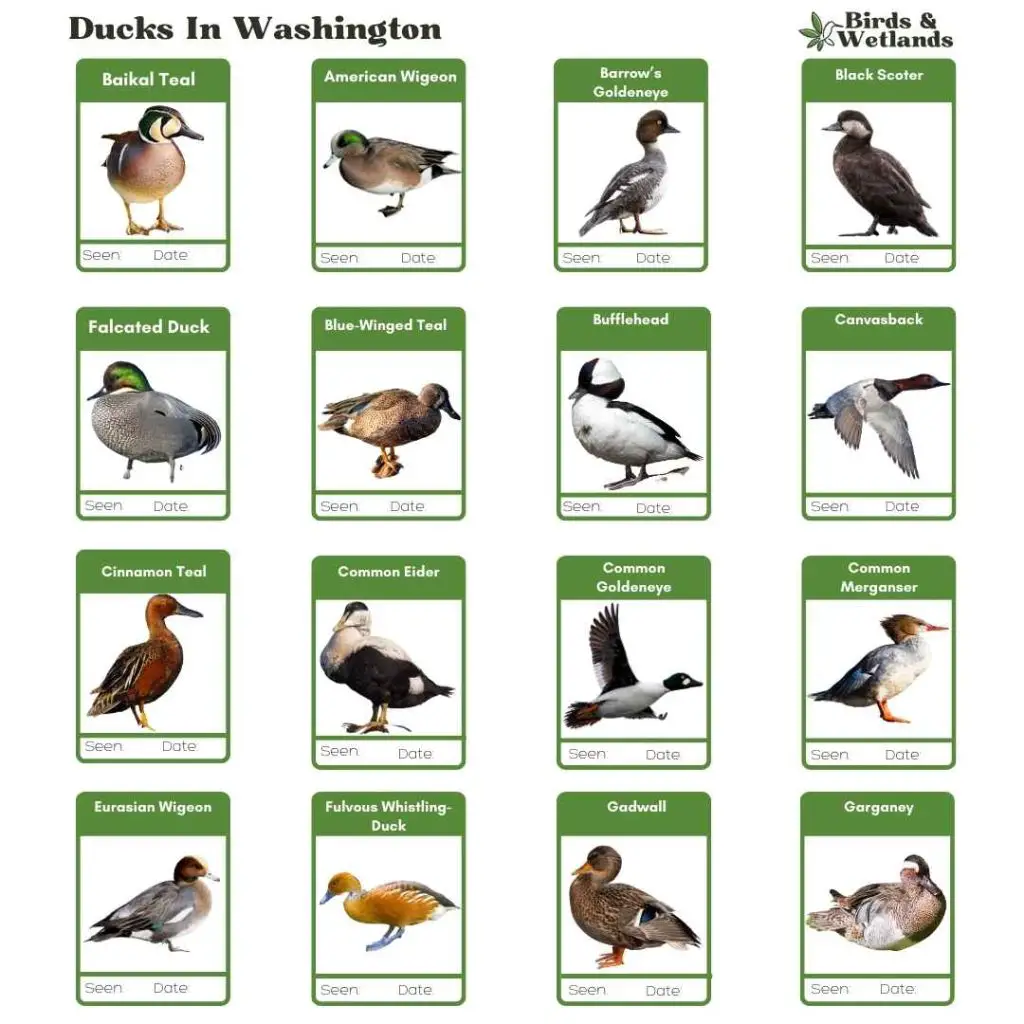
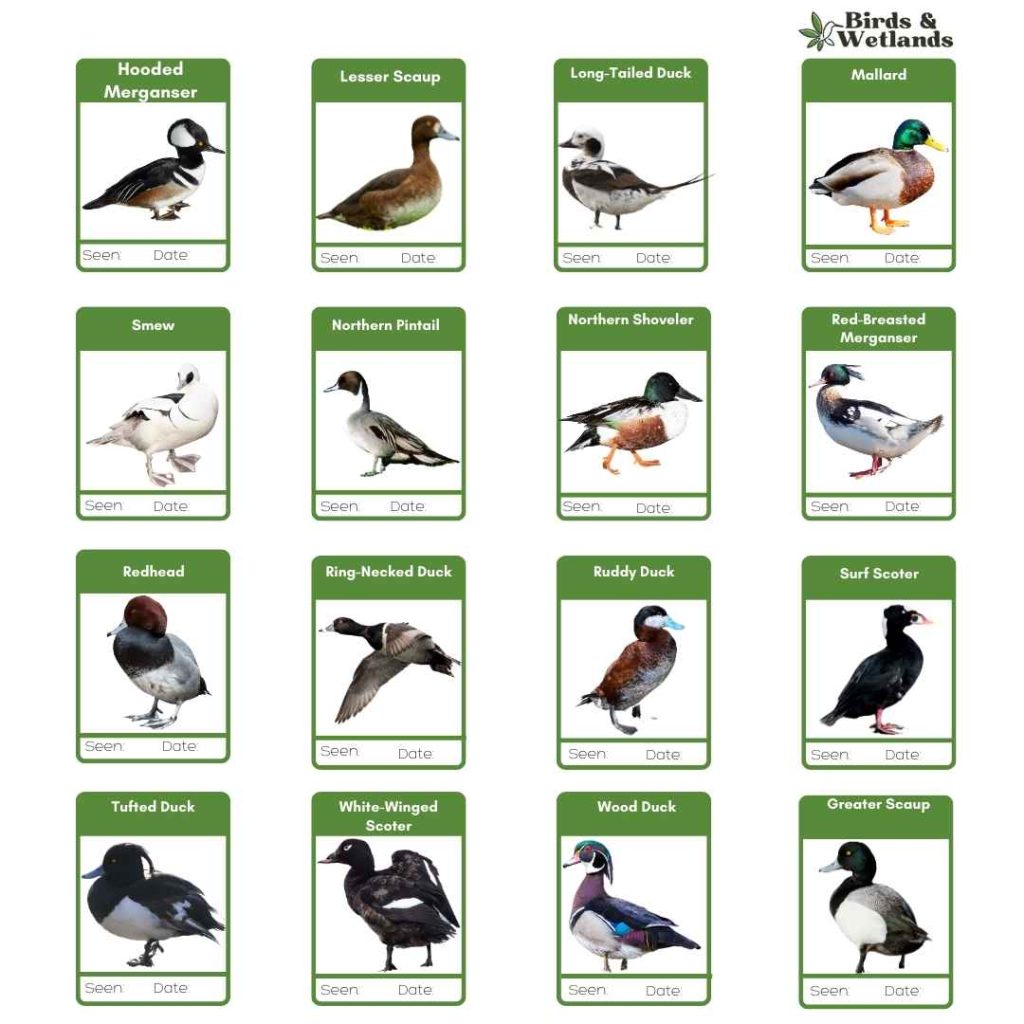

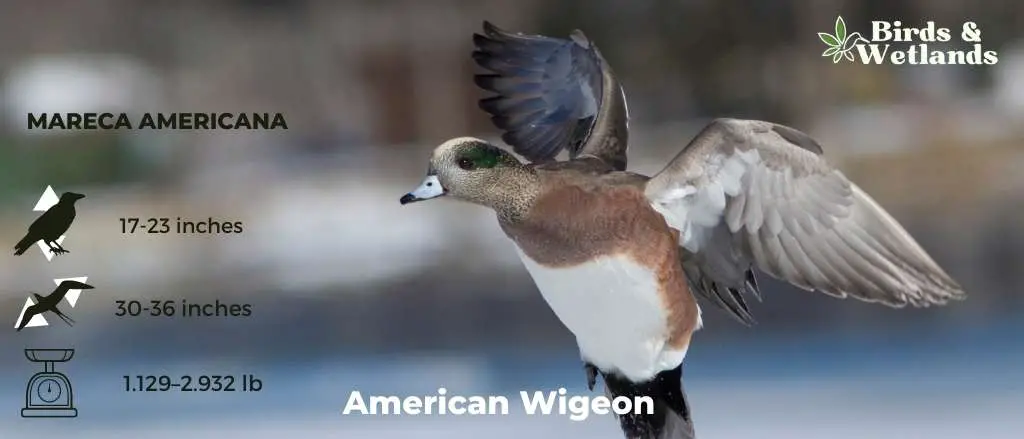
American Wigeon
Listen to American Wigeon
The American Wigeon is a dabbling duck found in North America. It is a medium-sized duck that is larger than a teal but smaller than a pintail. It is different than other North American dabblers with its round head, small bill and short neck.
Males have a distinct green stripe behind the eyes, a white crown and mostly brown bodies. Females have a dark smudge around the eyes, brownish-gray heads and warmer brown bodies.
The American Wigeon is common and widespread in North America. They breed in all regions of the continent except for the northern regions of Canada and Alaska. Most of the population of these ducks breed in wetlands in boreal forests and subarctic river deltas of Alaska and Canada.
During winter, many American Wigeons travel through the major flyways, they are most numerous on the Pacific Flyway. They spend winters in California’s Central Valley, Louisiana’s Gulf Coast and Texas Panhandle. Some flocks of wintering American Wigeons fly further south in the Caribbean.
As dabbling ducks, the American wigeons feed by dabbling and grazing but they are mostly found feeding on dry land. They eat grains, seeds, grasses, wheat and lettuce.
Scientific Name: Mareca americana
Height: 42–59 cm (17–23 in)
Wingspan: 76–91 cm (30–36 in)
Weight: 512–1,330 g (1.129–2.932 lb)
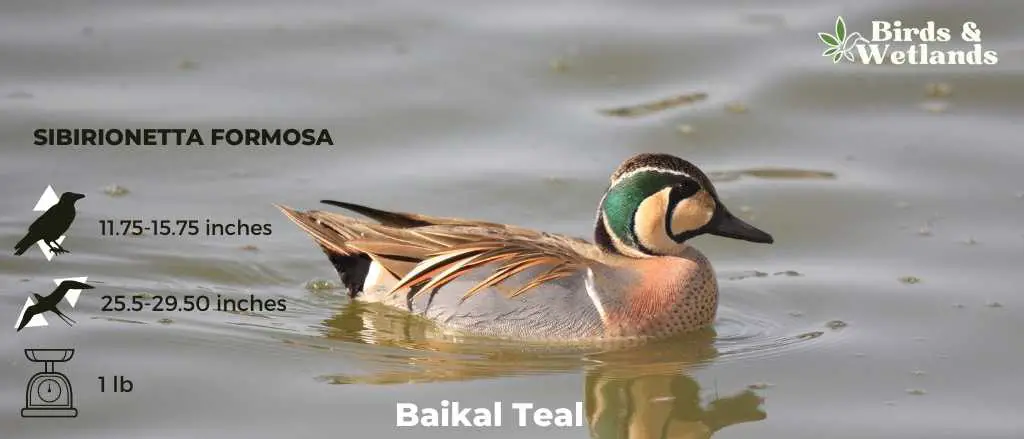
Baikal Teal
Listen to Baikal Teal
The Baikal Teal is a small duck that has a long, slender bill with a black tip, and its tail is short and slightly rounded. The male’s head and neck are blue-gray, and the rest of the body is an olive color with darker brown stripes. The female’s head is brownish gray, and its body is grayish-green with light brown markings.
Baikal teals can migrate thousands of miles each year to follow their food supply; they spend winters in coastal areas where they feed on marine life like fish eggs and crustaceans. They also eat small fish when necessary to survive harsh winters when there are no other food sources available for them to eat. They eat seeds from aquatic plants and insects found in lakes or ponds during their migration periods.
Baikal Teals are migratory birds that travel between Siberia, Alaska, and Canada during their breeding season. During the winter months, they can be found in China and Japan.
It is currently listed as “Least Concern” by the IUCN Red List due to its large population size and stable population trend.
Scientific Name: Sibirionetta formosa
Height: 11.75 to 15.75 inches
Wingspan: 65–75 cm
Weight: 1 pound
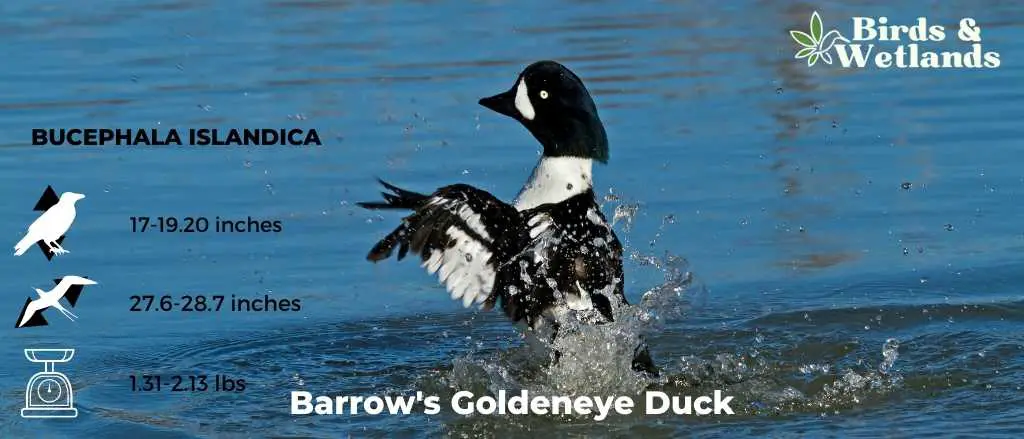
Listen to Barrow’s Goldeneye Duck
Barrow’s goldeneye is a medium-sized sea duck, named after Sir John Barrow.
Both males and females have a triangle head with a steep forehead. Males have a crescent-shaped white patch behind the dark bill and small white patches on their black wings. Females have brown heads with orange bills with black tips.
Barrow’s goldeneyes are scattered across North America, but they are primarily found in the northwestern part of the continent. These ducks inhabit ponds and wooded lakes. Barrow’s goldeneyes are migratory birds that spend winters in southern parts of the continent.
Barrow’s goldeneyes are diving ducks that forage food underwater. Their diet primarily consists of gastropods and mussels but they are also known to consume crustaceans, insects and water plants.
Scientific Name: Bucephala islandica
Length:
Male: 19.2 in (49 cm)
Female: 17 in (43 cm)
Wingspan: 27.6-28.7 in (70-73 cm)
Weight:
Male: 2.13 lb (970 g)
Female: 1.31 lb (590 g)
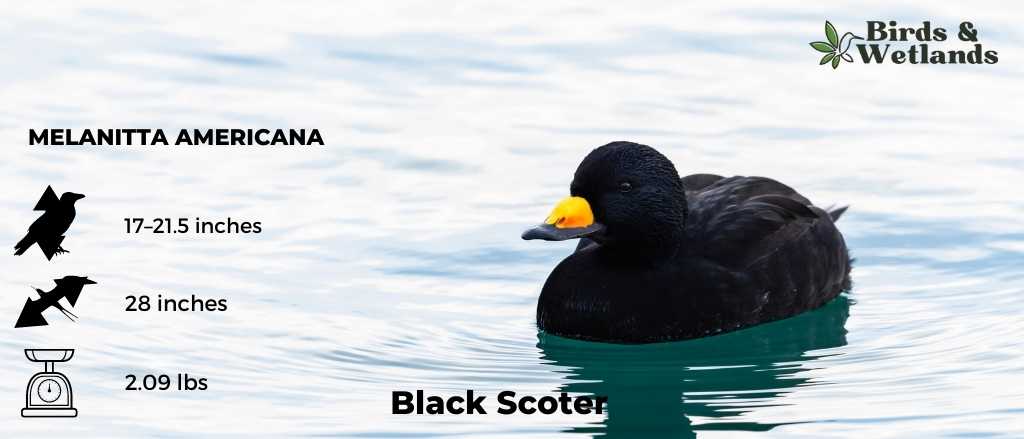
Black Scoter
Listen to Black Scoter
The black scoter, also known as the American scoter, is a relatively large sea duck with an average length of 49 cm (19 in). It has a bulky shape and a large bill.
Adult Males have an all-black plumage on both body and head except for the yellow knob at the base of their large bill. Females have smaller bills, brown bodies with pale faces.
Black scoters live near saltwater, ponds and small lakes. They breed in the northern regions of North America, particularly in Newfoundland, Labrador, and the northwest and southeast parts of Hudson Bay. Some flocks of black scoters breed in scattered locations east of Yana River on the Siberian side of the Bering Strait. During winter, they form large flocks of other wintering scoter specie and migrate south.
Black scoters dive underwater for mollusks, crustaceans and shellfish. They occasionally feed on floating vegetation such as duckweed.
There are an estimated 1 million black scoters worldwide. However, this duck’s number is declining due to habitat loss caused by climate change and pollution.
Scientific Name: Melanitta americana
Length: 430–550 mm (17–21.5 in)
Wingspan: 710 mm (28 in)
Weight: 950 g (2.09 lb)
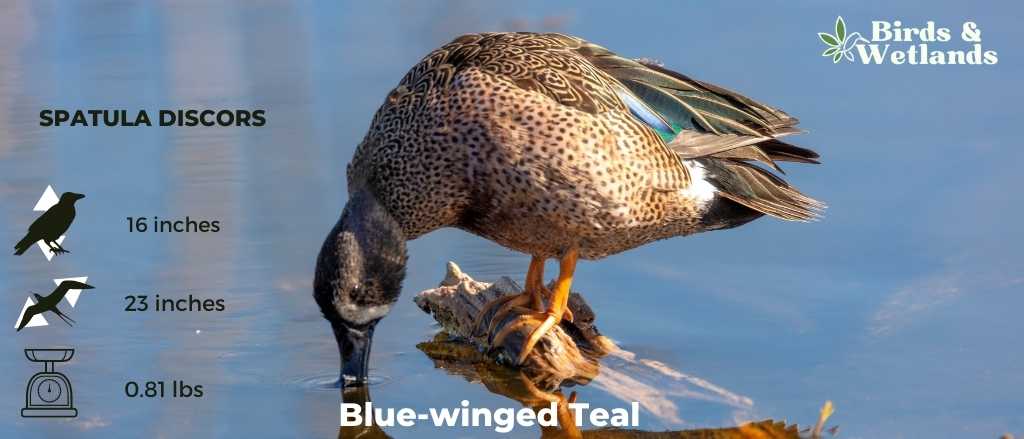
Blue-winged Teal
Listen to Blue-winged Teal
The Blue-winged Teal is a small duck that lives in North America.
Breeding males have a glossy blue-gray head with a white crescent-shaped patch in front of the dark eyes. They also have black wings and rears.
Females have mostly brown bodies with black bills, dark caps and eyeliners on the head.
The Blue-winged Teal’s diet consists mostly of aquatic plants like pondweed, but it will also eat insects when they are available. This duck often feeds by pecking at the surface of the water rather than diving for food. It will sometimes form small groups to feed together or fly in single file formation when migrating south for winter.
Blue-winged teals are found in marshes, ponds, lakes, and rivers throughout the United States south of Canada, and north of Mexico.
They are migratory birds and fly south for the winter months to warmer climates. It winters along the Atlantic coast from southern New England to Virginia and then moves further south as far as Mexico.
Scientific Name: Spatula discors
Height: 40 cm (16 in)
Wingspan: 58 cm (23 in)
Weight: 370 g (13 oz)

Bufflehead
Listen to Bufflehead
Buffleheads are striking ducks. They are small ducks with relatively large heads.
Males have a huge white patch on their iridescent purple-green heads. They also have short dark bills, white chests and flanks.
Females have a distinct white patch on the cheeks, rounded heads and brownish bodies.
Buffleheads breed in boreal forests and taigas of Alaska and Canada. They migrate to the southern parts of the United States, settling near coastal and open inland waters. Some flocks even travel as far as western Europe.
Buffleheads are diving ducks that dive underwater to forage for food. Just like other diving ducks, primarily feed on small aquatic insects, crustaceans and mollusks. They also consume aquatic plants occasionally.
Scientific Name: Bucephala albeola
Length: 32–40 cm (13–16 in)
Wingspan: 21.6 in (55 cm)
Weight: 270–550 g (9.5–19.4 oz)
Canvasback
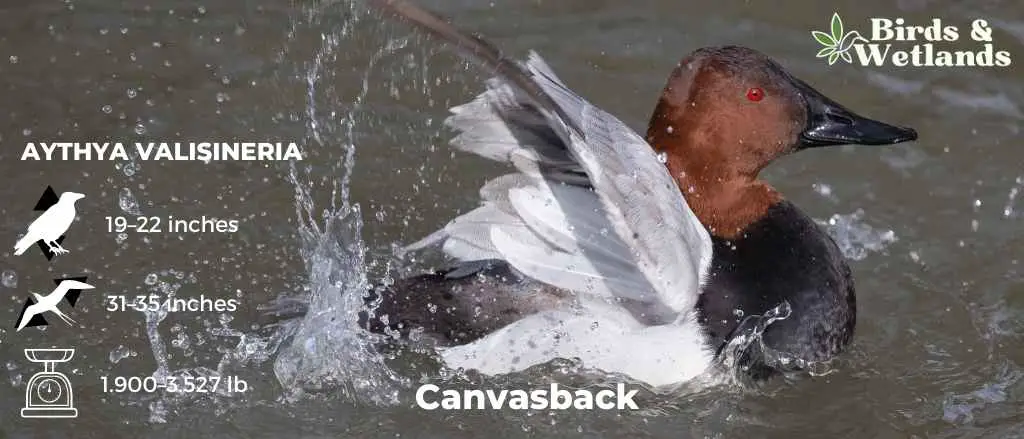
Canvasback
Listen to Canvasbacks
Canvasbacks are large diving ducks with sloping foreheads and dark bills. The male has red eyes, a black chest and a white body. The female has black eyes, a brown head and a pale gray body.
Breeding populations of canvasbacks are found scatted all over the North American prairie potholes and the subarctic river deltas of Saskatchewan and Alaska. These ducks prefer to nest over or near prairie marshes surround by protective vegetation such as bulrushes and cattails.
Canvasbacks are diving ducks which means they feed primarily by diving underwater. They eat a variety of plant materials such as seeds, leaves, tubers, roots and buds. They prefer sago pondweed tubers which consist 100% of their diets at times. These waterfowl also feed on snails, insect larvae and small fish.
Scientific Name: Aythya valisineria
Height: 48–56 cm (19–22 in)
Wingspan: 79–89 cm (31–35 in)
Weight: 862–1,600 g (1.900–3.527 lb)
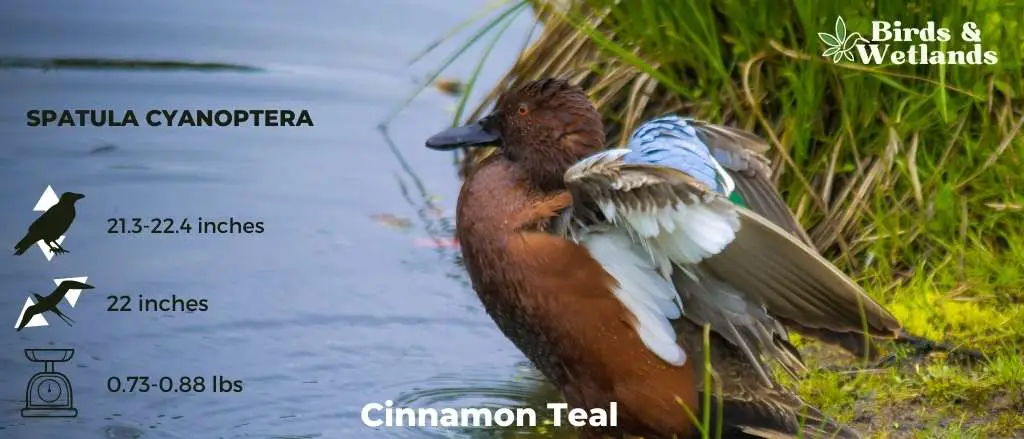
Cinnamon Teal
Listen to Cinnamon Teal
Cinnamon Teal is a small duck with distinctive bright cinnamon-colored feathers on its back, green patches on their wings and white markings above the eye that is native to North America and Central America.
The diet of this bird includes seeds, insects, and other invertebrates that are found near water sources where they live. Like most ducks, it feeds on aquatic vegetation such as pondweed, watercress, pondweed, and water lilies. This bird has also been known to eat insects and small crustaceans.
They are found in the northern hemisphere and are particularly common in North America, where they breed from Alaska to Canada. They winter south of the U.S., as well as in parts of Mexico and Central America.
The Cinnamon Teal is a very social bird, often living in large flocks during the breeding season and congregating around lakes and rivers during migration. They tend to be shy and elusive, so it can be difficult to see them in their natural habitat.
These birds mate for life and build nests on the ground near water sources—usually shallow ponds or marshes with tall grasses nearby for cover when young are being reared.
Scientific Name: Spatula cyanoptera
Height: 21.3-22.4 in (54-57 cm)
Wingspan: 22-inch (560 mm)
Weight: 11.8-14.1 oz (335-401 g)
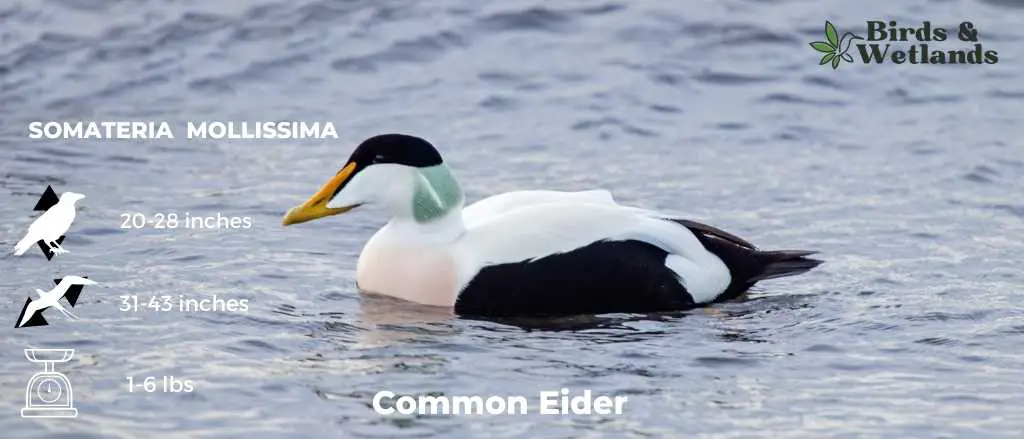
Common Eider
Listen to Common Eider
The common eider, sometimes known as the Cuddy’s duck or St. Cuthbert’s duck, is a huge sea duck with a round head and a thick neck found throughout the northern shores of Europe, North America, and eastern Siberia.
Common eiders have a long, rounded tail and a distinctive white patch at the base of the bill. Their plumage is predominantly black and white, with brownish-gray on their wings and back.
They prefer to live in shallow waters where they can dive for food easily. They feed on fish, mollusks, crustaceans, and other marine life. They are also known to eat dead fish found near shorelines. In winter, they can be found near open water such as estuaries or sheltered bays where there is access to ice floes for resting and feeding.
Common Eiders have several unique characteristics that make them stand out from other birds of their kind. Their legs are positioned so that when swimming underwater they can rotate their feet 180 degrees without having to lift them above the water’s surface.
They breed on coastal tundra lakes in northern Canada and Alaska. The population of Common eiders has been steadily declining over the years due to habitat loss caused by human activities such as logging operations, which destroy nesting habitats for these birds each year.
Scientific Name: Somateria mollissima
Length: 50–71 cm or 20–28 in
Wingspan: 80–110 cm (31–43 in)
Weight: 0.81 to 3.04 kg (1 lb 12+1⁄2 oz to 6 lb 11 oz)
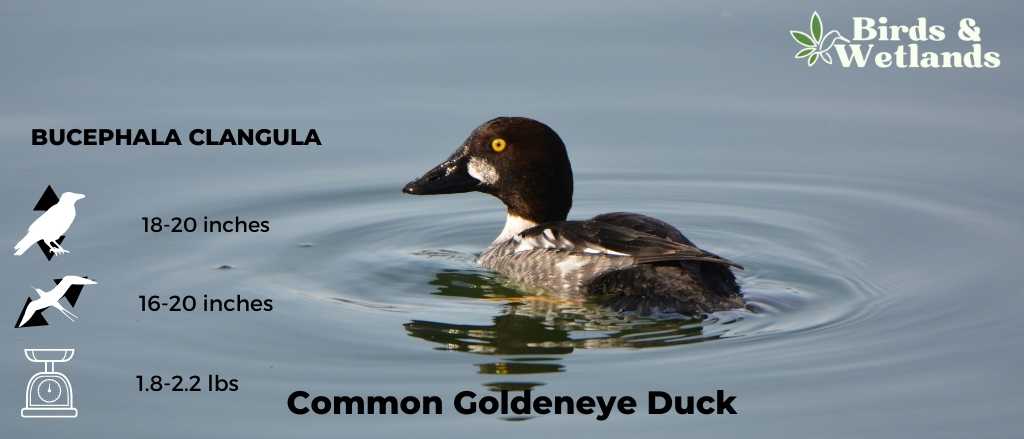
Listen to Common Goldeneye Duck
The Common Goldeneye Duck is a medium-sized diving duck that breeds across the northern hemisphere in North America, Asia, and Europe. It winters in the southern hemisphere.
Males have dark green heads with bright yellow eyes. They also have a distinctive white cheek patch. Their bodies are white with black back and rump.
Females have dark brown heads but with a short dark bill with a yellow tip at the end. They have grayish bodies, a white neck collar and pale yellow eyes.
Common Goldeneyes are also known for their unique calls. It sounds like a squeaky rubber toy being squeezed repeatedly. This makes them easy to identify by ear in addition to sight!
As one of North America’s most abundant ducks, Common Goldeneyes live in lakes, ponds, rivers, and marshes. Most of these ducks also live near shorelines where there is plenty of fish and vegetation available for food sources.
The Common Goldeneye Duck is listed as “least concern” by the International Union for Conservation of Nature (IUCN), which means that it isn’t threatened with extinction
Scientific Name: Bucephala clangula
Length:
Male: 45–51 cm (18–20 in)
Female: 40–50 cm (16–20 in)
Wingspan: 30.3-32.7 in (77-83 cm)
Weight:
Male: 1,000 g (2.2 lb)
Female: 800 g (1.8 lb)
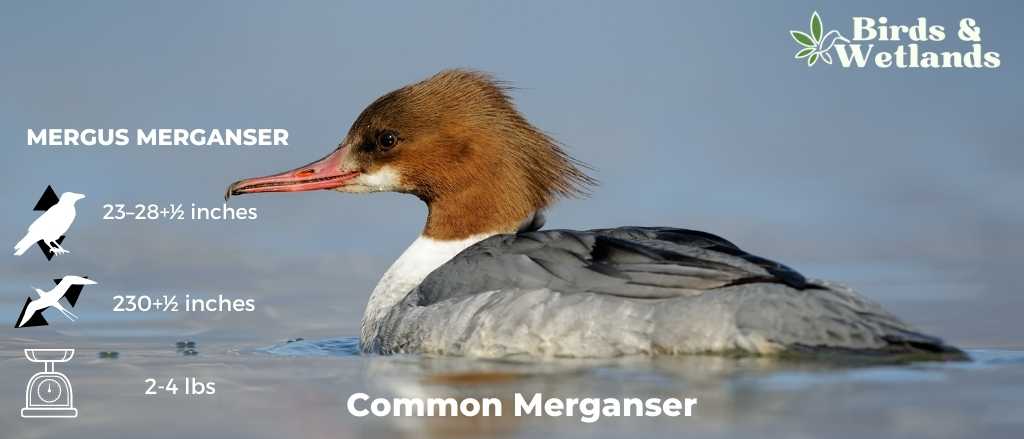
Common Merganser
Listen to Common Merganser
Common Mergansers are fairly large ducks with long slender bills, with different tip colors depending on gender. Males have black tips while females have brown tips.
Breeding males have long, large white bodies with a Mallard-like green head. Females have a ragged crest atop a warm cinnamon-colored head.
Common mergansers are omnivores, eating both plants and animals such as small fish or insects. They eat their prey by diving underwater and spearing it with their long bill before swallowing it whole.
The habitat of this bird is lakes, rivers, ponds, and marshes. They prefer quieter bodies of water with plenty of vegetation along the shores where they can rest during the day before moving on to hunt at night.
The current population of this bird is considered stable due to its ability to thrive even when there are threats present due to its adaptability as well as its wide range across North America.
Scientific Name: Mergus merganser
Length: 58–72 cm (23–28+1⁄2 in)
Wingspan: 78–97 cm (30+1⁄2–38 in)
Weight: 0.9–2.1 kg (2 lb 0 oz – 4 lb 10 oz)
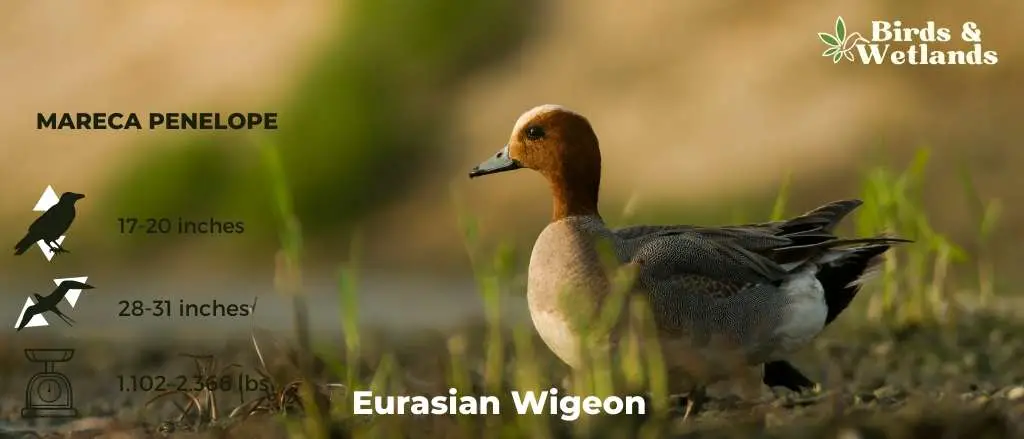
Eurasian Wigeon
Listen to Eurasian Wigeon
The Eurasian wigeon, or European wigeon, is a dabbling duck widespread in the Palearctic. It is a rare visitor in the United States, with a non-breeding population that spends winters in various parts of the country except for the southern Appalachian region and the Four Corners.
Males have bright rufous-brown heads and buffy crowns that contrast their gray-colored bodies. Females have mostly brown bodies with white bellies.
Eurasian wigeons nest near water and usually under cover of tall vegetation. They inhabit wet grasslands and marshes.
Eurasian wigeons breed in the Palearctic, northern parts of European and Russia. These birds migrate south to southern Asia and Africa for the winter. There is a small breeding population in Scotland that spends winters in Great Britain and Ireland.
Eurasian Wigeons eat mainly aquatic and terrestrial plants. Their diet consists of leaves, stems, roots, and seeds. They often feed on grasses, grains, seeds, duckweed, cattail, sedge and water milfoil. They are also known to feed on grains such as rice, wheat and barley. In addition to their main diet, they also occasionally eat mollusks, crustaceans, small fish, mayflies and beetles.
Scientific Name: Mareca penelope
Height: 42–52 cm (17–20 in)
Wingspan: 71–80 cm (28–31 in)
Weight: 500–1,073 g (1.102–2.366 lb)
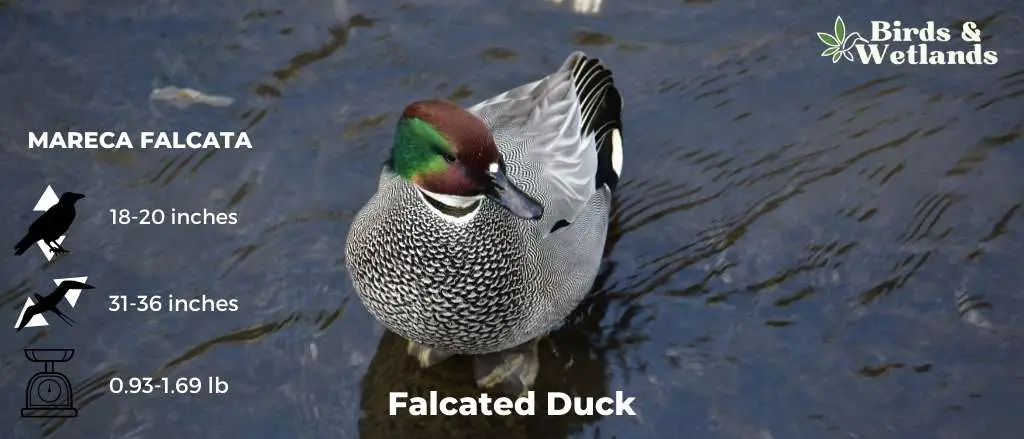
Falcated Duck
The Falcated Duck is a species of duck that lives in the wilds of North America, Canada, and Alaska making its home in the Pacific Northwest.
It has long legs and wings, making it one of the fastest ducks on earth. Its bill is also distinctive, with a downward curve at the end. Their legs are pinkish-grey and they have reddish-orange eyes. Their bills are a yellowish-green color with black tips. They also have a white stripe down their neck to their chest.
They’re omnivorous – eat aquatic plants and seeds, and animals. but on average they eat about 70% animal matter (like insects and small fish). It forages for food by diving underwater or dabbling at the surface, sometimes upending completely to reach roots or plant stems growing close to the surface of the water.
This duck is notable for its very distinctive bill and its unusual nesting habits—instead of building a nest that it sits on, this duck lays its eggs in shallow water and lets them incubate naturally. They are very social animals and live in small groups called “trios” or “flocks” during the breeding season (which lasts from mid-April to early July).
The breeding range of the falcated duck is from eastern Siberia and Mongolia to northeastern China and northern Japan with wintering grounds in the northern part of southeast Asia to northeastern India.
The Falcated Duck is a globally threatened species due to hunting pressure from humans who seek its meat as well as habitat loss due to drainage of wetlands where they breed and overwinter.
Scientific Name: Mareca falcata
Height: 46 to 53 cm (18–21 in)
Wingspan: 79 to 91 cm (31–36 in)
Weight: 422 to 770 g (14.9–27.2 oz)
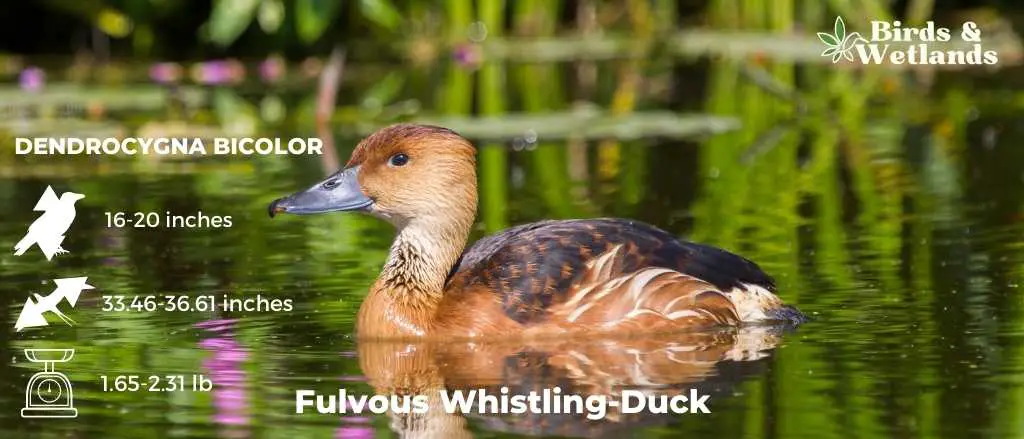
Fulvous Whistling-Duck
Listen to Fulvous Whistling-Duck
The Fulvous Whistling-Duck is a medium-sized duck that is found in Mexico, Central and South America, and the Caribbean. It has a light brown body and a yellow head with a white underside. They have a blackhead, neck, back, and tail. The males are more brightly colored than the females.
The habitat of this bird includes marshes, lakes, and ponds where they feed on seeds, aquatic plants, insects, and occasionally small fish. The Fulvous Whistling-Duck usually nests on the ground near water but may also nest in trees or cattails.
Their diet consists mostly of seeds from grasses or sedges as well as aquatic plants such as pondweeds or duckweed. They also eat invertebrates such as mollusks (snails), crustaceans (crayfish), or insects like dragonflies or beetles depending on what’s available in their habitat at different times of year (e.g., dragonflies during breeding season).
The population of this species has been declining due to habitat loss caused by agriculture and urbanization; however, there are currently no known threats to its continued existence.
Scientific Name: Dendrocygna bicolor
Height: 16 to 20 inches (40 to 50 centimeters)
Wingspan: 85 to 93 cm
Weight: 748–1,050 g (26.4–37.0 oz)
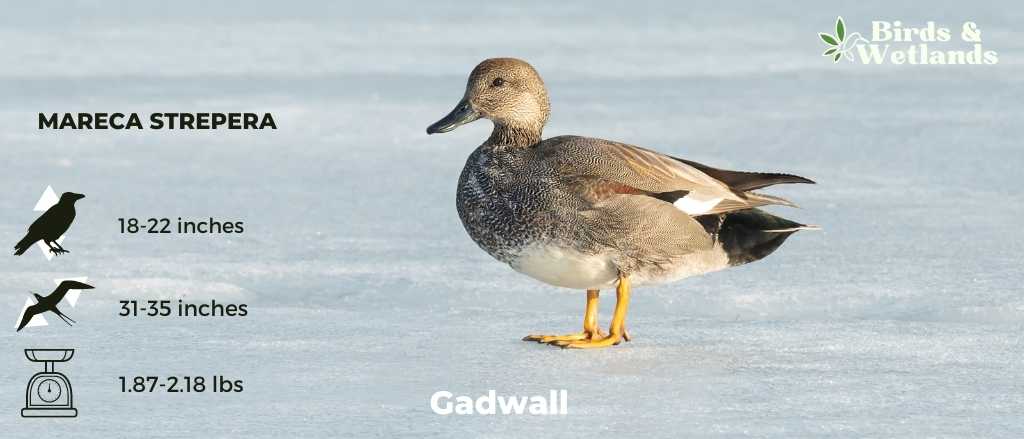
Gadwall
Listen to Gadwall
The Gadwall is a common dabbling duck with breeding populations in northern parts of North America, Europe and Russia.
Males have overalls of an intricate pattern of gray, brown and black. They have dark bills. Females resemble female mallards with mottled brown bodies.
The gadwall nests on the ground near open wetlands with dense vegetation such as steppe lakes, marshes and wet grasslands.
Gadwalls are migratory birds. Their North American population spends winters in the southern parts of the United States, Mexico and Central America.
Gadwalls are omnivores. They primarily eat submerged vegetation such as grasses, pondweed, algae, and water milfoil. They also eat snails, water beetles and other small invertebrates.
Scientific Name: Mareca strepera
Height: 46–56 cm (18–22 in)
Wingspan: 78–90 cm (31–35 in)
Weight
Male: 990 g (35 oz)
Female: 850 g (30 oz
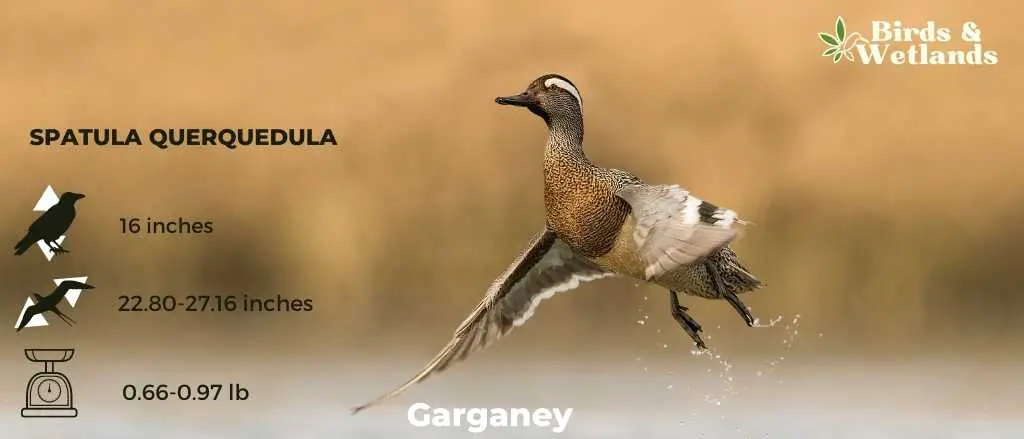
Garganey
Listen to Garganey
Garganey is a small duck with a slender body, long neck, and short bill. It has a black head, neck, and upperparts. The breast is white with dark spots in the center of each feather. The flanks are brownish-gray and the belly is white. The legs and feet are orange-yellow.
The Garganey feeds on insects, mollusks, fish, frogs, and worms. It nests near water, where it can be seen diving for food with its bill pointed downward.
The garganey’s habitat includes shallow freshwater lakes, ponds, and marshes with reeds or other tall vegetation near them. They live in flocks during the breeding season but tend to be solitary during migration and winter months.
It breeds over most of Europe and the Palearctic, as well as northern Asia and North America but it is purely migratory, with the whole population migrating to Southern Africa, India, Bangladesh, and Australasia during the Northern Hemisphere winter, when vast flocks may be seen.
The garganey is listed as Least Concern by IUCN due to its large range estimated at 1 million km2 (390 000 mi2).
Scientific Name: Spatula querquedula
Height: 41 cm
Wingspan: 58 – 69 cm
Weight: 300- 440 g
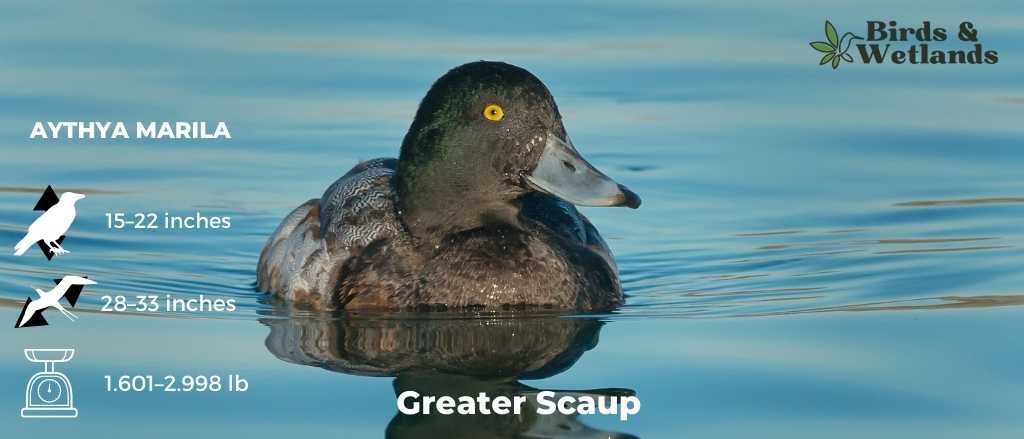
Greater Scaup
Listen to Greater Scaup
The Greater Scaup is a large diving duck with a rounded head, dark chest and a distinctive white band on its head. The rest of its body is brown with a blue-grey sheen on its back and tail (which can be seen when they fly). The male is larger than the female, with a more pronounced bill and more white wing feathers. It has a black bill, black feet and legs, and gray plumage.
They prefer shallow water close to shore where they can feed on aquatic vegetation and small fish. They are omnivorous creatures who feed on mollusks, crustaceans, insects (especially water beetles), worms, and other small invertebrates like larval dragonflies which comprise about 60% of their diet.
This species breeds in the northern taiga regions of Canada and Alaska and winters in the Atlantic and Pacific Oceans, as well as some inland lakes. It is an uncommon sight in North America but can be found in many areas across Europe, Asia, Africa, and Australia. In winter, it migrates to southern Canada and parts of the northeastern United States.
Scientific Name: Aythya marila
Height: 39–56 cm (15–22 in)
Wingspan: 71–84 cm (28–33 in)
Weight: 726–1,360 g (1.601–2.998 lb)
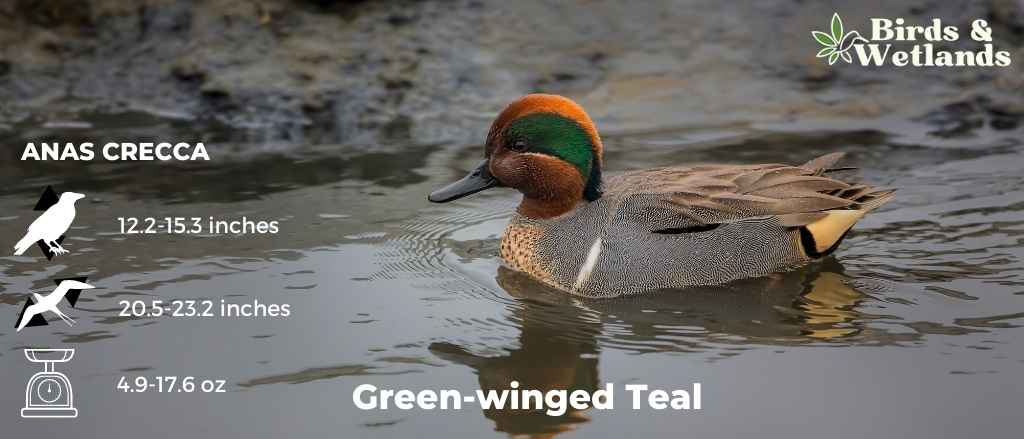
Green-winged Teal
Listen to Green-winged Teal
Green-winged Teals are among the most common ducks in the northern regions of North America except on the Aleutian Islands. They are the smallest dabbling ducks on the continent.
Breeding males have chestnut-colored heads with a green streak behind the eye. They also have gray-barred bodies with a vertical white stripe on the sides. Females have a mottled brown plumage, similar to that of female Mallards. They have a dark eye-line.
Both males and females have a green patch on the wings which are hidden often hidden while they are resting but visible when in flight.
Green-winged Teals breed in the northern parts of North America. Breeding populations of these ducks are found in the Aleutian Islands, northern Alaska, northern Saskatchewan and other northern Canadian provinces.
Green-winged Teals primarily eat plant matter such as seeds, stems and leaves. They also consume grains such as millets, wheat, corn and barley. The green-winged teal may occasionally feed on mollusks, crustaceans, maggots of decaying fish and insects. They search for food on mud flats, shallow marshes and flooded agricultural lands.
Scientific Name: Anas crecca
Height: 12.2-15.3 in (31-39 cm)
Wingspan: 20.5-23.2 in (52-59 cm)
Weight: 4.9-17.6 oz (140-500 g)
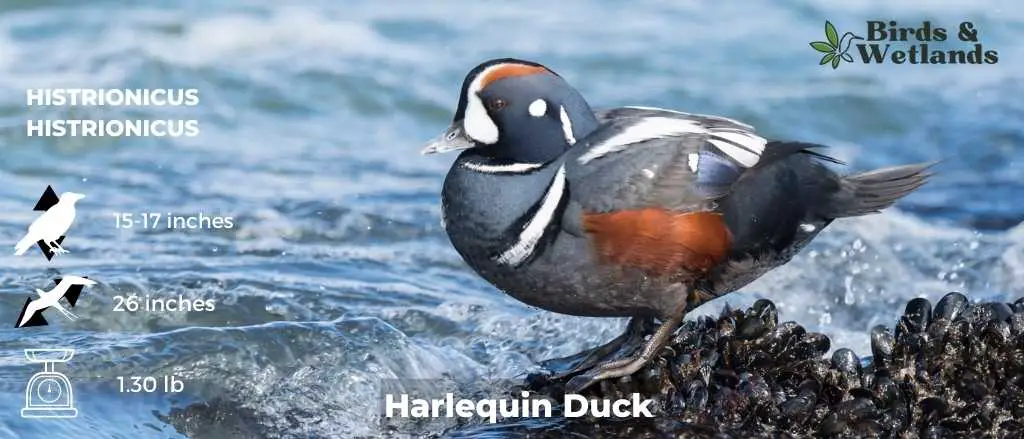
Harlequin Duck
Listen to Harlequin Duck
The Harlequin Duck is a beautiful small sea duck that is native to North America. It has a unique appearance. It has a black head, neck, and breast, with white cheeks and sides of the neck, and red eyes. The body is black with white spots on the wings and tail feathers.
In addition to being unique-looking birds, Harlequin Ducks are also very vocal animals who make sounds such as whistles and squeaks that can be heard from up to 100 yards away! These sounds are used primarily for communication between other ducks within a flock but can also be used to alert predators of danger if needed (such as when approaching land).
These birds feed on small fish and crustaceans such as shrimp and clams. They can dive up to 20 feet below the surface to catch their prey.
It can be found in coastal areas of North America, Europe, and Asia, where it lives in salt marshes. It lives in freshwater lakes, ponds, and rivers. The species is monogamous and breeds in April and May.
Unfortunately, these beautiful creatures are currently under threat from habitat loss due to human development as well as overfishing.
Scientific Name: Histrionicus histrionicus
Length: 15–17 in (380–430 mm)
Wingspan: 26 in (660 mm)
Weight: 600 g (1.3 lb)
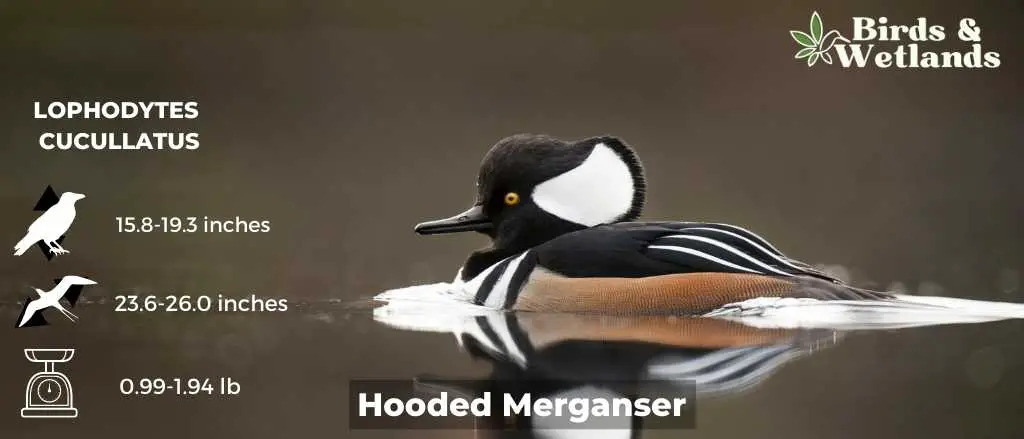
Hooded Merganser
Listen to Hooded Merganser
The Hooded Merganser is a relatively small duck with a slender body and a long tail.
Breeding males have a large black crest with a large white patch on each side. They also have golden yellow eyes.
Females have brown bodies with a slightly lighter colored crest which looks like a mohawk. They have dark eyes.
Non-breeding males look similar to females but with yellow eyes.
Hooded mergansers live in North America and spend most of their time in freshwater ponds, lakes, estuaries and rivers. These ducks migrate south for the winter but there are some flocks that stay in the eastern United States all year.
The hooded merganser’s diet consists primarily of small fish, aquatic insects, crustaceans, and frogs. Depending on the circumstances, these ducks may occasionally feed on plants and seeds.
Scientific Name: Lophodytes cucullatus
Length: 15.8-19.3 in (40-49 cm)
Wingspan: 23.6-26.0 in (60-66 cm)
Weight: 16.0-31.0 oz (453-879 g)
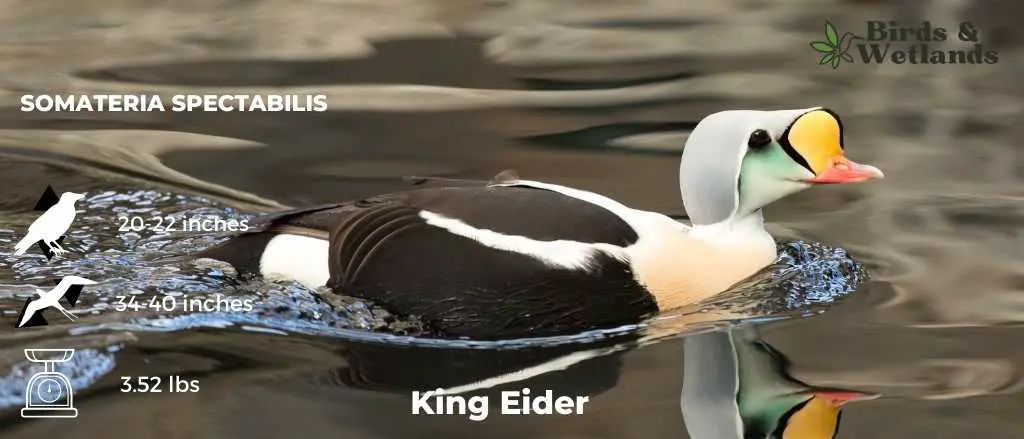
King Eider
Listen to King Eider
Audio Player00:0000:00Use Up/Down Arrow keys to increase or decrease volume.
credit https://xeno-canto.org/181183
The King Eider is a large sea duck that breeds in Arctic and sub-Arctic regions from Alaska to Greenland and along most of the northern Hudson Bay shoreline.
It is so named because of its magnificent crest, which it can raise or lower at will. It has a stocky body, a large head, and a short neck. Its plumage is brownish-gray on the back and sides, with a white belly and chest.
The King Eider prefers breeding grounds near the sea, where they can feed on mussels and other shellfish. They also eat small fish and crustaceans.
This species is found in coastal areas near water during the summer months, but it will migrate during winter months to coastal areas away from ice sheets where it can find food. They typically live about 15 years in the wild but have been known to live up to 35 years in captivity.
This bird can dive to depths of about 30 meters for over 30 seconds at a time in search of food such as small fish or mollusks.
The king eider is listed as Vulnerable by Birdlife International because its population has declined by more than 10% since 1980 due to overhunting in some parts of its range.
Scientific Name: Somateria spectabilis
Height: 52–57 cm (20–22 inches)
Wingspan: 86–102 cm (34–40 in)
Weight: 1.6 kg
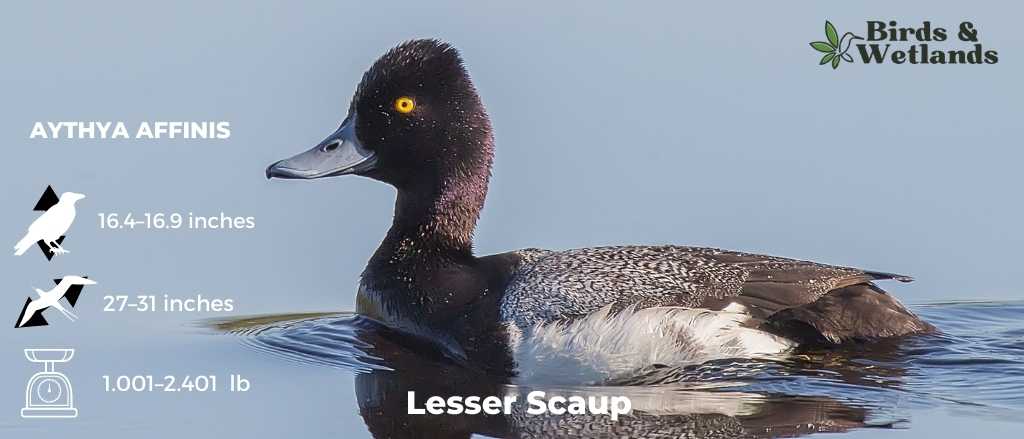
Lesser Scaup
Listen to Lesser Scaup
The Lesser Scaup is a small diving duck native to North America and winter in Central America. Lesser Scaups are smaller than Greater Scaups.
Males have golden yellow eyes. Their chests and heads are black with a purple sheen. Their sides are white while their backs have an intricate pattern of gray and white feathers.
Females have darker heads than males. They have gray sides and brown bodies with a white patch around the base of their bills.
The Lesser Scaup’s habitat is typically freshwater lakes, rivers, and streams. They can also be found on large ponds and reservoirs with plenty of aquatic vegetation.
Lesser Scaups eat mostly fish but also insects and small crustaceans, which they find by diving beneath the surface of the water for up to 40 seconds at a time.
Lesser scaups breed in ponds and lakes across Canada and much of the northern United States from late April through May. They usually nest in colonies with other species such as Mallards and Common Goldeneyes.
The Lesser Scaup is not considered to be endangered or threatened and is currently listed as Least Concern by the International Union for Conservation of Nature (IUCN).
Scientific Name: Aythya affinis
Height: 41.7–43 cm (16.4–16.9 in)
Wingspan: 68–78 cm (27–31 in)
Weight: 454–1,089 g (1.001–2.401 lb)
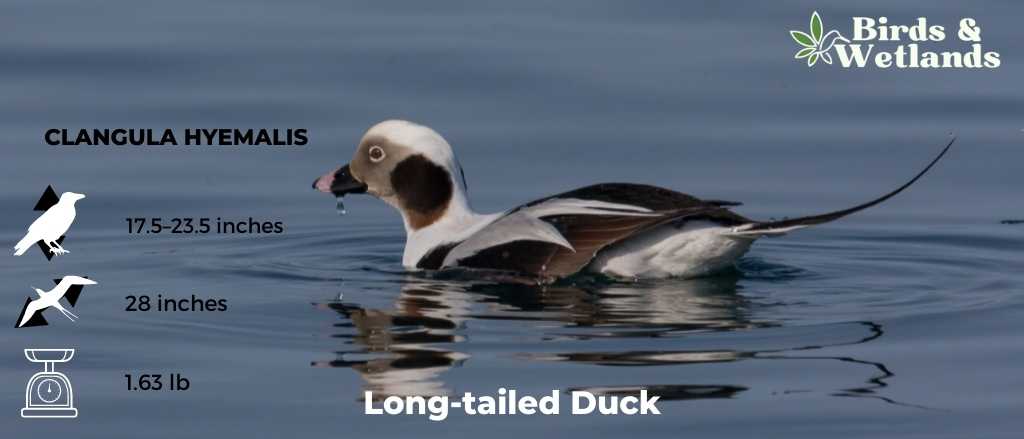
Long-tailed Duck
Listen to Long-tailed Duck
Long-tailed Ducks are species of duck that are native to Australia and New Zealand. They are named for their long, narrow tail feathers, which can be over 30% longer than the rest of their body. It has a black bill, brown eyes, and grayish-brown feathers on its back and wings. The underside of the bird is white in color.
The Long-tailed Duck eats aquatic plants, seeds, insects, snails, mollusks, crustaceans, fish eggs, and small fish. They can dive up to 60 feet below the surface.
These species of duck prefer to live in areas where there are plenty of lakes and ponds for them to feed on. They are also known for being very territorial so they tend not to share their space with other species unless they have no choice but to or if they’re trying to breed.
They are migratory birds, traveling from Canada to Europe during the summer months before returning south for winter months in North America or Asia.
They can be found in Europe, Asia, North America, and parts of South America. They breed in freshwater lakes from May through July or August depending on where they live. They migrate to southern latitudes during the winter months to avoid freezing temperatures.
Long-tailed Ducks have a current population of roughly 2 million individuals worldwide—that’s down from an estimated 4 million during the 1980s.
Scientific Name: Clangula hyemalis
Length: 440–600 mm (17.5–23.5 in)
Wingspan: 710 mm (28 in)
Weight: 740 g (1.63 lb)

Mallard
Listen to Mallard
Mallards are native to the Northern Hemisphere. These ducks live in many parts of the United States and Canada.
Male mallards have a lustrous green head, with a thin white collar that sets off his dark chestnut breast. His back is a rich brown, and his tail is adorned with iridescent blue and green feathers. The female mallard has mottled brown overalls with orange and brown bills.
The Mallard’s diet consists mostly of seeds, fruit, and insects. These ducks have been known to consume small rodents when available. They usually feed at night in shallow water or on land near water sources.
Most Mallards live in wetlands such as ponds, lakes, and rivers. They also inhabit saltwater environments close to lands such as bays and estuaries.
Mallards are also social birds that travel in flocks during the breeding season. Males and females form monogamous pairs during the winter months when they migrate southward to warmer climates.
Scientific Name: Anas platyrhynchos
Height: 50–65 cm (20–26 in)
Wingspan: 81–98 cm (32–39 in)
Weight: 0.7–1.6 kg (1.5–3.5 lb)
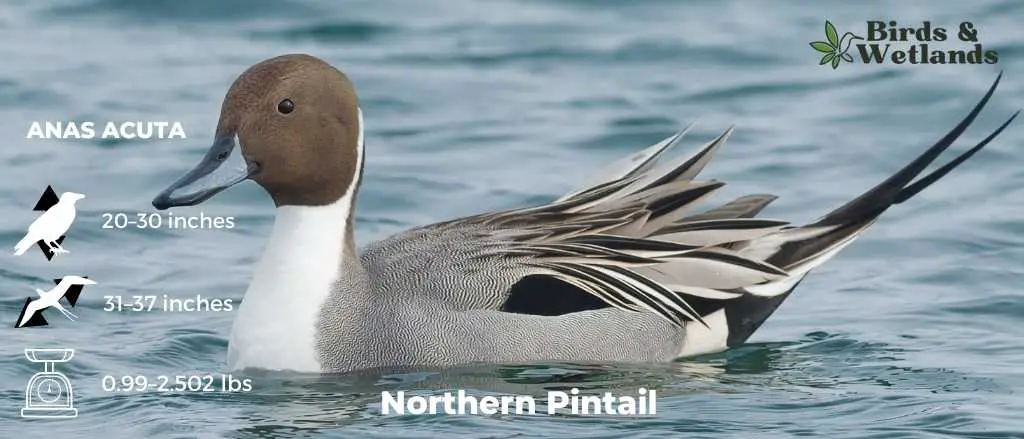
Northern Pintail
Listen to Northern Pintail
Northern Pintails are slender ducks with relatively long necks and tails. The male has a cinnamon-brown head, a white breast and throat. While males have gray bodies, females have rufous-brown plumage. Both sexes have a pale black-gray bill.
The Northern Pintail is a migratory bird that nests on or near open water with some vegetation nearby.
Northern Pintails feed on aquatic plants such as bulrush roots, pondweeds, and sedges. They also feed on seeds from different plants like grass, insects such as dragonflies, fish and other small animals worms and tadpoles.
There are approximately 1 million Northern Pintails left in the wild today.
Scientific Name: Anas acuta
Height:
Male: 59–76 cm (23–30 in)
Female: 51–64 cm (20–25 in)
Wingspan: 80–95 cm (31–37 in)
Weight:
Male: 450–1,360 g (0.99–3.00 lb)
Female: 454–1,135 g (1.001–2.502 lb)
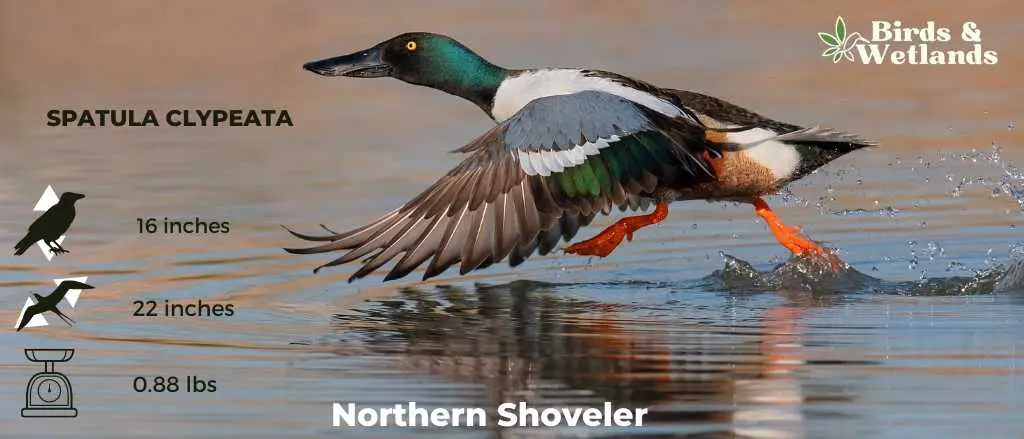
Northern Shoveler
Listen to Northern Shoveler
The northern shoveler, often known as the shoveler in the United Kingdom, is a common and ubiquitous duck. With its brown head and neck and breast, greenish-yellow bill and wings, white breast and belly, and dark greenback, and black tail feathers, it’s hard to mistake for any other duck species. Females have blue patches on their wings.
This duck lives in freshwater ponds, marshes, lakes, rivers, and streams but will also sometimes inhabit brackish water areas where the water has a high salt content. It breeds in North America from Canada to Mexico, migrating south for the winter months.
The Northern Shoveler’s diet consists primarily of aquatic plants like duckweed and water lettuce. It also eats insects, worms, crustaceans, and mollusks if they can find them in the water.
Wintering in southern Europe, the Indian subcontinent, Southeast Asia, Central, the Caribbean, and northern South America, it breeds in northern Europe, through the Palearctic, and across much of North America.
Scientific Name: Spatula clypeata
Height: 16 in (41 cm)
Wingspan: 22-inch (560 mm)
Weight: 14 oz (400 g)
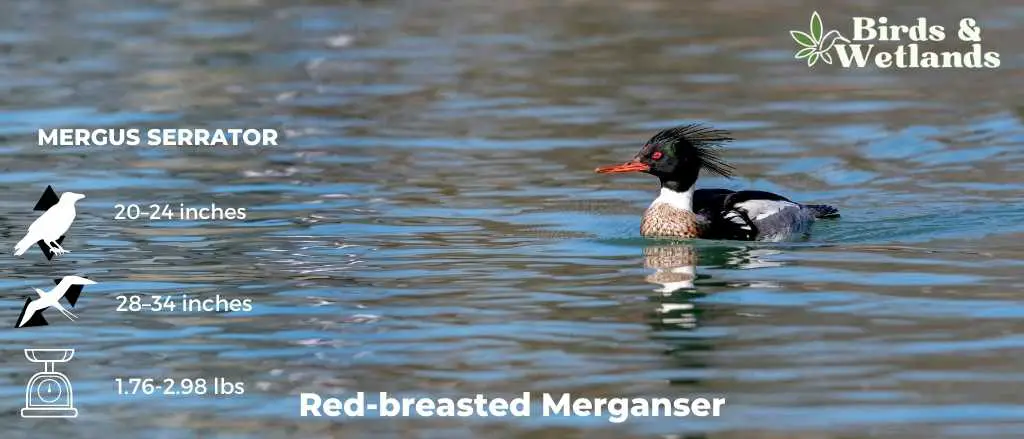
Red-breasted Merganser
Listen to Red-breasted Merganser
Red-breasted Mergansers have long, slender bodies with equally long, thin bills and gray flanks.
Breeding males have cinnamon chests, red eyes, white neck bands and shaggy-looking green heads. The back and wings are dark brown, with some iridescent feathering on the wings.
Non-breeding males and females have mostly grayish bodies, spiky reddish-brown heads and brown eyes.
Red-breasted Mergansers feed on small fish by diving into the water. They use their wings to propel themselves forward like penguins do when swimming underwater.
Red-breasted Mergansers breed in boreal forests of North America. They inhabit lakes, rivers, and ponds where they can search for food and protect themselves against predators.
Scientific Name: Mergus serrator
Length: 51–62 cm (20–24 in)
Wingspan: 70–86 cm (28–34 in)
Weight: 28.2 to 47.6 oz (800 to 1,350 g)
Redhead
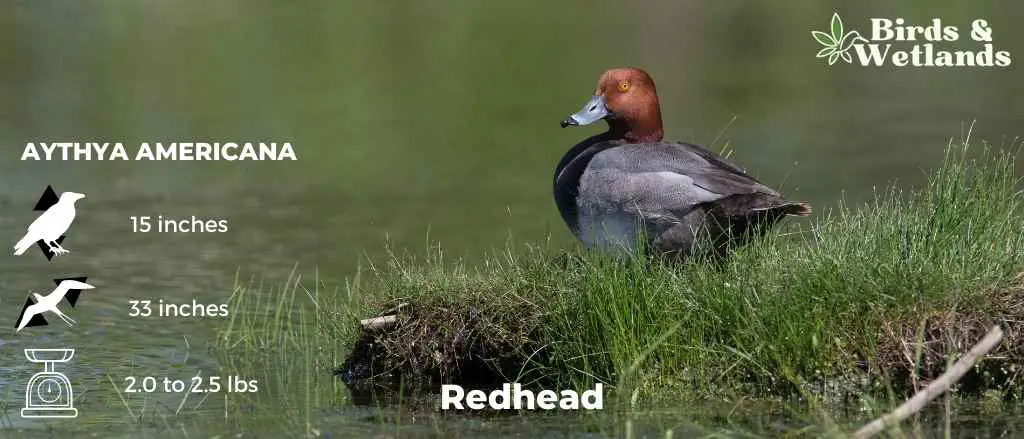
Redhead
Listen to Redhead
The redhead is a medium-sized diving duck. On average, it weighs 2.5 lbs (1.1 kgs). This duck species is related to the common pochard and canvasback.
Both males and females have a steep forehead. Males have cinnamon-red heads with black-tipped gray bills, black chests and gray bodies. Females have brown bodies and pale faces.
Redheads can be found throughout North America, with the exception of southern Mexico and parts of the southeastern United States. They are most common in coastal areas and large rivers. In fact, many people mistake them for musk ducks when they see them in freshwater habitats.
Redheads are migratory birds and migrate south in the winter. Many flocks of redheads spend winters in Florida, Texas, Louisiana, Oregon, California and along the Gulf of Mexico.
Redheads primarily live in wetlands, lakes, rivers, coastal marshes, estuaries and bays. These ducks prefer to inhabit areas near the water that is deep enough to provide a variety of food sources such as aquatic plants and small fishes.
Scientific Name: Aythya americana
Height: 37 cm (15 in)
Weight: 2.0 to 2.5 lbs
Wingspan: 84 cm (33 in)
Ring-necked Duck (Aythya collaris)
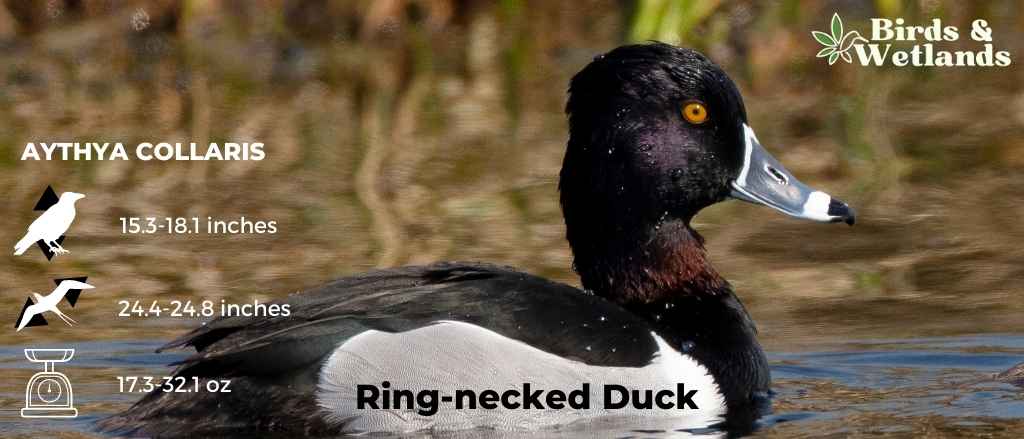
Ring-necked Duck
Listen to Ring-Necked Duck
The ring-necked duck is a medium-sized diving duck commonly found in lakes and ponds of North America, Central America and northern regions of South America.
Ring-necked ducks have a white band and a black tip at the end of their gray bills. Males have glossy black heads and yellow eyes while females have grayish brown heads and dark eyes.
Breeding populations of ring-necked ducks are found throughout the northern United States and Canada. A few flocks of these ducks breed in the eastern region of Canada.
During winter, flocks of ring-necked ducks migrate to the warmer climates of the southern United States, Central America and northern regions of South America.
Ring-necked ducks inhabit rivers, bays, ponds and lakes where they feed on submerged vegetation. The bulk of their diet consists of stems, seeds, tubers and leaves of pondweed, wild celery and water lilies. When available, they also consume grains such as wild rice and millet. As omnivores, ring-necked ducks are also known to feed on aquatic invertebrates, worms, leeches, snails, nymphs and dragonflies.
Scientific Name: Aythya collaris
Height: 15.3-18.1 in (39-46 cm)
Wingspan: 24.4-24.8 in (62-63 cm)
Weight: 17.3-32.1 oz (490-910 g)
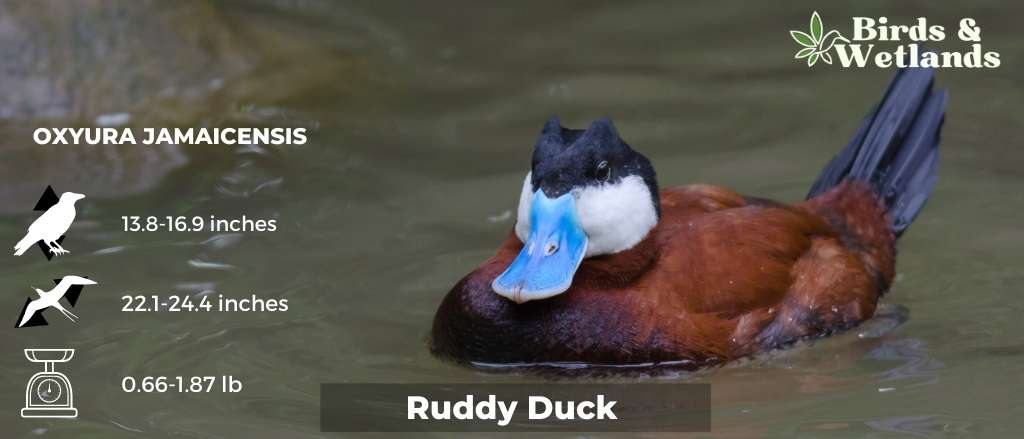
Ruddy Duck
Listen to Ruddy Duck
Ruddy Ducks, commonly referred to as Ruddies, are medium-sized ducks of North America.
Male ruddy ducks in their breeding plumage are unlike any other duck you’ve seen. They have thick necks, white cheeks and bright blue bills.
Females and non-breeding males are soft orange-brown with a dark, scoop-like bill.
Ruddy Ducks are omnivorous, eating plants and insects as well as fish and small animals. It eats insects, grains, seeds, and aquatic plants. They are monogamous animals; they mate for life and have one clutch per year of 4-6 eggs that hatch after 25 days.
Ruddy Ducks frequently move in small groups of 5–15 birds at night. They’re also very sociable animals.
Ruddy Ducks live in freshwater lakes, ponds, rivers, marshes, and swamps. They are migratory birds that spend the winter in South America. They are typically found in freshwater lakes and marshes during the breeding season (April through August), but they can also be seen on rivers or coasts during migration or wintering months (October through February).
Scientific Name: Oxyura jamaicensis
Length: 13.8-16.9 in (35-43 cm)
Wingspan: 22.1-24.4 in (56-62 cm)
Weight: 10.6-30.0 oz (300-850 g)
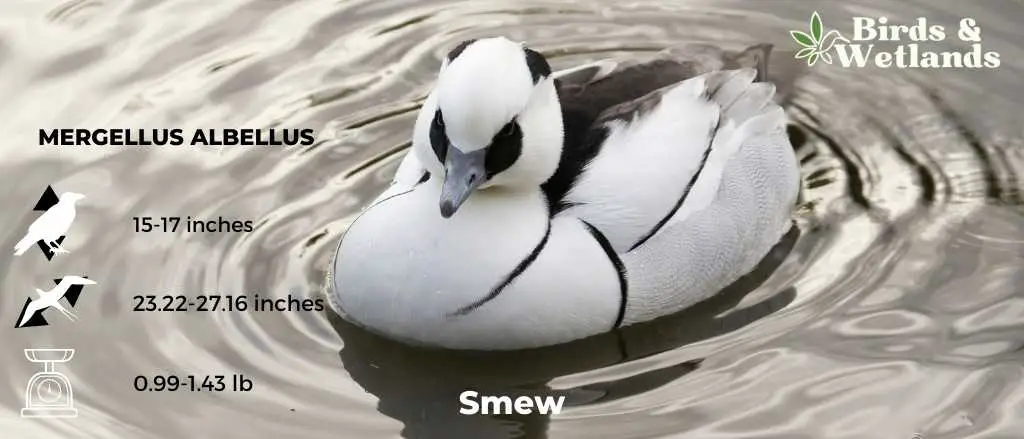
Smew
Listen to Smew
The smew is a duck species and the sole extant member of the Mergellus genus. Mergellus is a diminutive of Mergus, while albellus is derived from the Latin word albus, which means “white”.
The male has a black face mask and thin black markings on the sides of his breast and flanks. The female has a dark reddish-brown head with a large white cheek patch and neck. The black-and-white appearance in flight is stunning.
They are omnivorous birds that feed on fish such as sticklebacks, perch, roach, insects, frogs, crustaceans, mollusks, worms, spiders, and small rodents, but they’ll also eat insects if they’re available.
The smew can be found in freshwater lakes, ponds, rivers, and marshes throughout Europe, Asia, and North America as far north as Alaska. They can also be found in Japan, China, and Korea where they have been introduced as well as in Canada where they have been introduced from Europe.
In terms of conservation status, there are no imminent threats currently facing this species.
Scientific Name: Mergellus albellus
Length: 38–44 cm (15–17 in)
Wingspan: 56–69 cm
Weight: 450–650 g
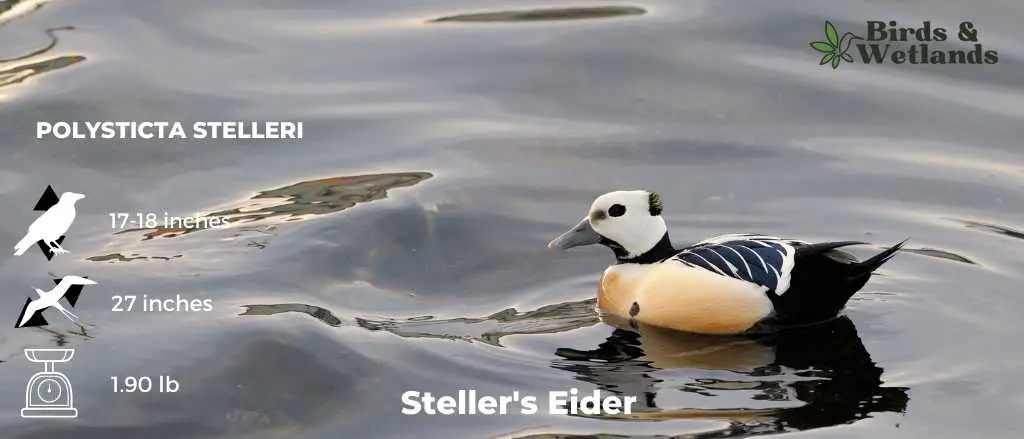
Steller’s Eider
Listen to Steller’s Eider
The Steller’s eider is a migratory Arctic diving duck that breeds along the Russian and Alaskan coasts. It is the eider species that is the rarest, tiniest and quickest flying.
The duck’s diet includes mollusks, crustaceans, other invertebrates, fish, and small aquatic animals. They can be found in the ocean and on land during the summer months, but migrate to warmer climates during the winter months.
The habitat of this bird includes rocky coasts, islands, or open tundra areas with freshwater ponds or lakes. This bird can be found in Russia, Alaska, Canada, Greenland, Iceland, Norway, and Sweden.
They nest in April through June before migrating back to their wintering grounds in September through October.
Steller’s Eiders have been listed as critically endangered by the IUCN due to loss of habitat due to climate change (melting sea ice) and hunting for food by humans who live in their breeding area (Alaska). Since 1994 because there are less than 50 breeding pairs left in the wild.
Scientific Name: Polysticta stelleri
Height: 430–460 mm (17–18 in)
Wingspan: 690 mm (27 in)
Weight: 860 g (1.90 lb)
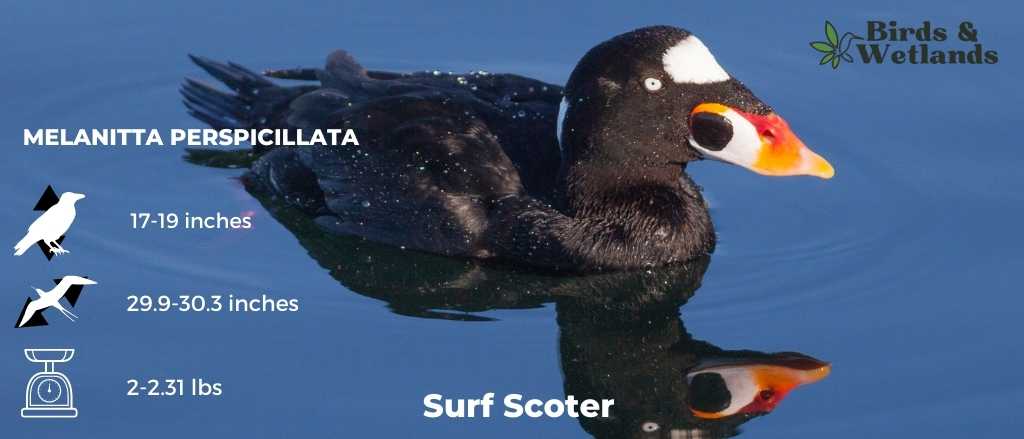
Surf Scoter
Listen to Surf Scoter
The surf scoter is a medium-sized sea duck native to North America. Males are mostly black with white patches at the back of the neck and crown. Their sloping orange bills. Females are mostly grayish brown with dark-sloping bills.
Surf scoters breed exclusively in North America, particularly in the northern regions of Canada and Alaska. Most flocks of surf scoters spend winters along the Atlantic and Pacific coasts of North America.
Surf scoters live near oceans and other large bodies of water. As sea ducks, surf scoters almost exclusively prey on creatures near or on the sea floor called benthic invertebrates. These creatures include marine snails, mussels, clams, small crabs and hydrozoans. They also feed on aquatic plants on occasion.
Scientific Name: Melanitta perspicillata
Length:
Male: 48 cm (19 in)
Female: 44 cm (17 in)
Wingspan: 29.9-30.3 in (76-77 cm)
Weight:
Male: 1,050 g (2.31 lb)
Female: 900 g (2.0 lb)
Tufted Duck (Aythya fuligula)
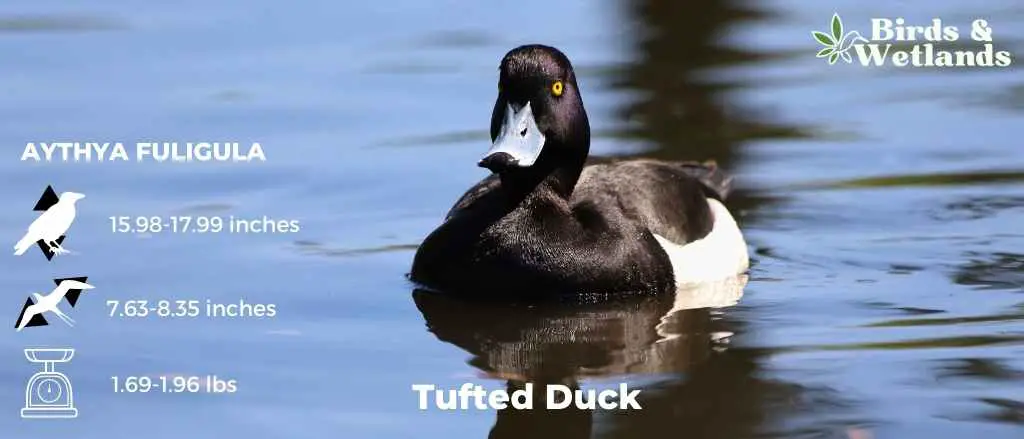
Tufted Duck
Listen to Tufted Ducks
Males are all black with white flanks, blue-gray bills and golden yellow eyes. They have an obvious head tuft and a thin crest on the back of their head. Females have dark chocolate brown overalls, with heads that are slightly darker than their bodies.
Tufted ducks breed in the northern regions of Eurasia. They form large flocks when migrating south for the winter. They have been spotted along the east and west coasts of the United States and Canada.
Tufted ducks live near freshwater lakes, coastlines, ponds and rivers. They prefer areas with tall vegetation to conceal their nests.
When it comes to diet, tufted ducks love mussels and other small mollusks. Occasionally, they eat plants and grass.
Scientific Name: Aythya fuligula
Height: Male: 40.6-45.7 cm Female: 40.6-45.7 cm
Wingspan: Male: 20.2-21.2 cm Female: 19.4-20.7 cm
Weight: Male: 889.6 g Female: 768.3 g
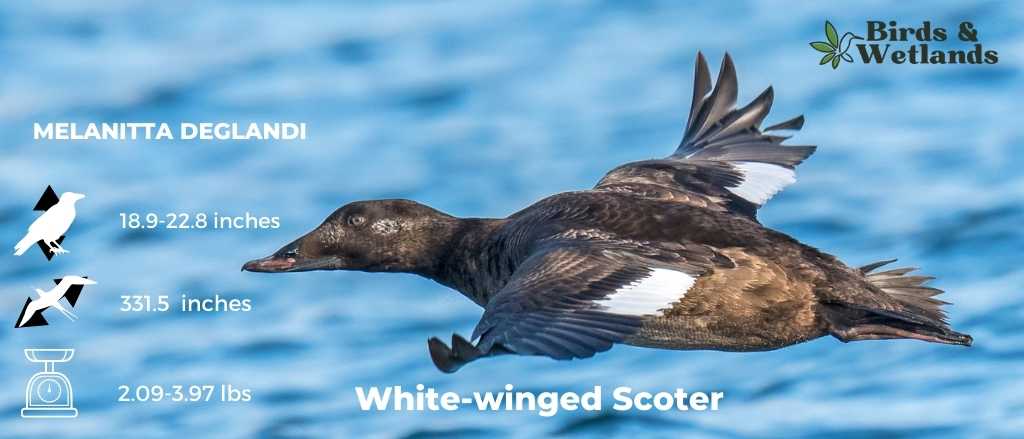
White-winged Scoter
Listen to White-winged Scoter
The White-winged Scoter is classified as an “oceanic” bird because it spends most of its time in marine waters. They have white feathers on their wings and are named after the white patch on their back. It is a medium-sized duck that has a black head, neck, and upper body, with a white breast and belly. The rest of its plumage is dark brown.
They feed primarily on mollusks, crustaceans, and fish, which they find by sweeping their bills side to side through the water in search of prey. When this happens, you’ll hear them make a loud clacking noise with their bills—which is how they got their name “scoter”.
It prefers to make its home near the coastlines of North America, Europe, and Asia. They can be found in large groups of other waterfowl but prefer to keep themselves separate from them.
They are migratory birds that make seasonal journeys between Canada and Mexico each spring/summer season before returning south for the winter months (December through April).
Scientific Name: Melanitta deglandi
Length: 18.9-22.8 in (48-58 cm)
Wingspan: 31.5 in (80 cm).
Weight: 33.5-63.5 oz (950-1800 g)
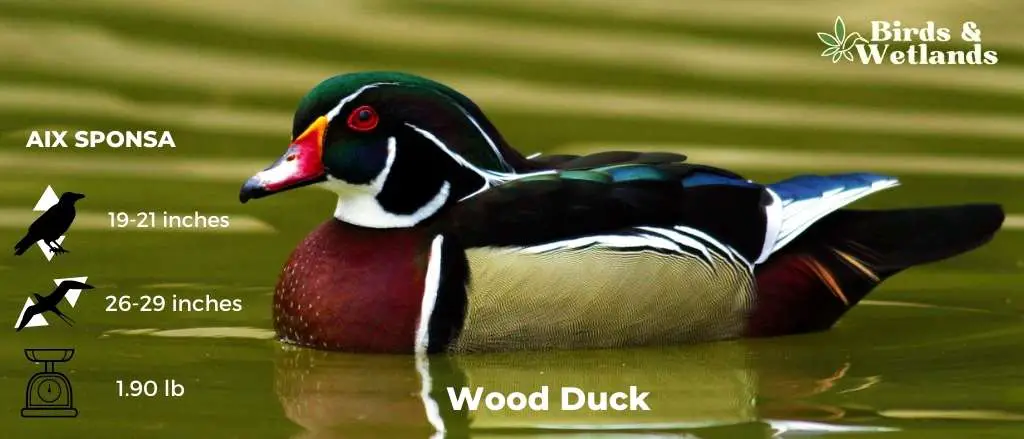
Wood Duck
Listen to Wood Duck
The Wood Duck is a medium-sized duck. The male wood duck has a green crested head, red eyes, and chestnut breast with white flecks. The female has a brown body with a grayish head, which is also slightly crested, a white teardrop eye patch, and a blue patch on the wing.
Breeding populations of wood ducks are found in eastern and western United States, southern Canada and western parts of Mexico. During winter, northern wood ducks migrate south but birds in the southern parts of North America stay all year round, especially those in the Pacific Flyway.
Female and male wood ducks inhabit wood areas near the water such as ponds, rivers, lakes, marshes and swamps. They nest in cavities of dead trees, elevated nesting boxes and properly installed nest boxes in wetland locations.
Wood ducks are omnivores. They either dabble on the surface of the water or graze on the land. Their diet primarily consists of acorns, seeds, grapes, cherries and other water plants such as water lilies and pond weeds. They occasionally feed on small animals such as insects and worms.
Scientific Name: Aix sponsa
Height: 47 to 54 cm (19 to 21 in) ( or 1.5 feet max.)
Wingspan: 66 to 73 cm (26 to 29 in)
Weight: 454-862 g (16.0-30.4 oz)
What Ducks Are in Washington?
Washington, with its diverse landscapes, thriving wetlands, and varied habitats, is an exceptional destination for birdwatchers and nature enthusiasts looking to observe a wide array of duck species.
Notable birdwatching locations within the state include the Nisqually National Wildlife Refuge, the Ridgefield National Wildlife Refuge, and the Skagit Wildlife Area, all offering ample opportunities for exploration and admiration of these captivating ducks.
One such spot is Ridgefield National Wildlife Refuge. The refuge has many grasslands, wetlands, and forests where many ducks congregate.
Many species of ducks live in Skagit Valley Wildlife Area, including a diverse array of waterfowl including goose species. Ospreys and bald eagles can also be seen in the area.
Over 200 species of birds are recorded at the Nisqually National Wildlife Refuge, another excellent place to see ducks. The refuge also offers hiking, fishing, and picnicking opportunities.
Venturing eastward, you’ll encounter the picturesque landscapes of Idaho, which host the bountiful duck populations in Idaho, offering a fresh perspective on these delightful birds.
Drive south and explore the captivating duck habitats in Oregon and immerse yourself in the state’s rich ecosystems, appreciating the beauty and variety of ducks found throughout the region.
Are There Any Resident Ducks in Washington?
There are quite a few ducks that call Washington home all year. The mallard is the most common duck in the state and can be found in just about any body of water, from lakes to ponds to marshes.
Wood ducks are also fairly common and often seen near wooded areas or streams. While some flocks of these ducks migrate south in the winter, others are year-round residents of the state.
Duck Hunting in Washington
Duck hunting in the state of Washington is among the best in the entire country. The state has an excellent waterfowl habitat, with a diverse range of wetlands and many public lands. The state hosts over 100 major bodies of water, many of which are open to hunting.
Duck hunting season in the state usually runs from October to January. To hunt ducks, hunters must have a valid hunting license, a Federal migratory bird stamp, a small game license and a state migratory bird permit.
Can You Shoot Ducks in Washington?
While shooting ducks is permitted in Washington during duck hunting season, it is important to be aware of the regulations surrounding duck hunting. In the state, non-toxic shots must be used when hunting waterfowl. This means that lead shots cannot be used when hunting ducks.
Where to Hunt Ducks in Washington?
Washington offers some of the most incredible duck hunting experiences in the country. The state’s relatively wet climate and location along the Pacific Flyway attract many migratory birds, including several duck species.
One of the best areas for duck hunting is the area along the banks of the Columbia River. The Columbia River provides a perfect habitat for ducks, and the site is also home to other wildlife.
Spokane has large flocks of ducks, and the area also has several lakes and ponds that provide good locations for duck hunting.
Western Washington has many public lands open for sea duck hunting. Hunters that prefer a guided hunt can also pay for outfitters.
Final Thoughts on Ducks in Washington
Washington is home to a diverse range of wildlife, including many species of ducks. The state’s lakes, rivers, and vast tracts of wetlands draw some ducks and other waterfowl. Ducks also use the state’s coastline to rest and refuel before traveling to their final wintering grounds further south.

